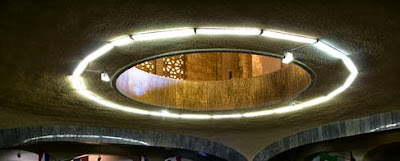The Voortrekker
Monument is situated in the northern part of South Africa in the Pretoria
(Tshwane) region in a nature reserve. It is a unique Monument which
commemorates the Pioneer history of Southern Africa and the history of the
Afrikaner and is situated in a beautiful setting. Today it is the most visited
heritage site of its kind in Gauteng and one of the top ten cultural historical
visitor attractions in the country.
Physically,
the Voortrekker Monument is 40 metres high, with a base of 40 metres by 40
metres.[citation needed] The building shares architectural resemblance with
European monuments such the Dôme des Invalides in France and the
Völkerschlachtdenkmal in Germany but also contain African influences. The two
main points of interest inside the building are the Historical Frieze and the
Cenotaph.
 The idea to
build a monument in honour of the Voortrekkers was first discussed on 16
December 1888, when President Paul Kruger of the South African Republic
attended the Day of the Covenant celebrations at Blood River in Natal. However,
the movement to actually build such a monument only started in 1931 when the
Sentrale Volksmonumentekomitee (SVK) (Central People's Monuments Committee) was
formed to bring this idea to fruition.
The idea to
build a monument in honour of the Voortrekkers was first discussed on 16
December 1888, when President Paul Kruger of the South African Republic
attended the Day of the Covenant celebrations at Blood River in Natal. However,
the movement to actually build such a monument only started in 1931 when the
Sentrale Volksmonumentekomitee (SVK) (Central People's Monuments Committee) was
formed to bring this idea to fruition.
Construction
started on 13 July 1937 with a sod turning ceremony performed by chairman of
the SVK, Advocate Ernest George Jansen, on what later became known as Monument
Hill. On 16 December 1938 the cornerstone was laid by three descendants of some
of the Voortrekker leaders: Mrs. J.C. Muller (granddaughter of Andries
Pretorius), Mrs. K.F. Ackerman (great-granddaughter of Hendrik Potgieter) and
Mrs. J.C. Preller (great-granddaughter of Piet Retief).
The Monument
was inaugurated on 16 December 1949 by the then-prime minister D. F.
Malan.[citation needed] The total construction cost of the Monument was about £
360,000, most of which was contributed by the South African government.
A large
amphitheatre, which seats approximately 20,000 people, was erected to the
north-east of the Monument in 1949.
The main entrance of the building leads into the domed Hall
of Heroes. This massive space, flanked by four huge arched windows made from
yellow Belgian glass, contains the unique marble Historical Frieze which is an
intrinsic part of the design of the monument. It is the biggest marble frieze
in the world































